Jan 30, 2009
Mature Arctic Ivory Gull Seen in Massachusetts - First Time in Over a Century
By Anthony Watts, Watts Up With That
One of the claims about “global climate change” is that it will affect the normal ranges of flora and fauna of our planet. Well, with a very cold northern hemisphere this winter, that seems to happening. A bird not seen (as a mature adult) in Massachusetts since the 1800’s , an Ivory Gull, normally an inhabitant of arctic areas, has been spotted. Here are the details from the Plymouth, MA Patriot-Ledger. - Anthony
GULL-LOVER’S TRAVELS: Birdwatchers flock to Plymouth to spot rare specimen
PLYMOUTH — Jan 28th, 2009
The temperatures were in the single digits, but not low enough to keep the gawkers away. A celebrity was in town, behind the East Bay Grille, a visitor not seen in these parts in decades, if not longer. But these weren’t paparazzi, and this wasn’t a Hollywood star. Rather, they were avid birdwatchers - about 20 in all - braving the frigid air as they scanned the bay and the edges of the breakwater with binoculars and spotting scopes.
And they would be rewarded, catching a glimpse of a glimpse of a rare, fully mature ivory gull. A birdwatcher reported seeing one in Plymouth last week, and another was spotted at Eastern Point Lighthouse in Gloucester. From Sunday through Tuesday, the avian visitor was a regular in Plymouth, much to the delight of birdwatchers, who came from near and far in hopes of adding the extremely rare bird to their life list.
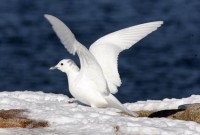
Ivory gulls normally stay well above Newfoundland, living on Arctic ice where they follow whales and polar bears to feed on the scraps and carcasses they leave behind after making a kill. Until this year, the last report of a fully mature ivory gull in Massachusetts was in the 1800s. Three immature birds were seen in the 1940s. In 1976, another immature bird had been spotted in Rockport.
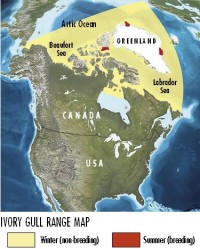
Russell Graham of Dallas is flying in Friday for a three-day visit. He’s hoping the gull will still be in town when he arrives. “The ivory gull is one of a handful of birds that every birder dreams of seeing but almost no one has” he said. “This isn’t a dream that’s confined to North America. There is also an immature bird in France that is causing the same reaction there. There are a couple of places where you can go in the summer and expect to see one but they are distant and expensive - Svalbard on Spitsbergen, Norway and Pond Inlet on Baffin Island, Canada. “I never thought I would have the chance to see one and I can’t pass up this once-in-a-lifetime opportunity.”
If the gull is gone, Graham will consider a side trip to Nova Scotia, where two adult ivory gulls have been seen recently. “I’ll be keeping my fingers crossed,” he said. John Fox of Arlington, Va., and his friend Adam D’Onofrio of Petersburg drove more than eight hours on Sunday to see the gull.
“No bird this morning,” Fox said a day later, shaking his head. “We left Virginia at three in the morning yesterday and arrived here 20 minutes too late.”
On Sunday morning, hundreds of people got to observe and photograph the gull as it fed on a chicken carcass someone put out on one of the docks in the parking lot. The bird stayed until 11 a.m., then flew across the harbor. It was not seen again for the rest of the day. Read more here.
Heavy snow has been common since 1992/93 in the northeast up to southeast Canada. Boston had more snow in the period from 1992/93 to 2004/05 than any other dozen years in history (since the 1880s). Last Boston had 52 inches last year, already 49 inches this year with a January nearly 5 degrees colder than normal. January 2004 was even more brutal in fact the third coldest month in Boston ever - see the Nantucket ferry and ice breaker stuck in ice in the photo below that year (courtesy TKelley).
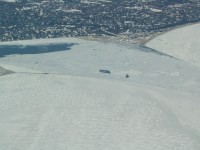
Larger here
Jan 29, 2009
The Amazing Story Behind the Global Warming Scam
By John Coleman, Coleman’s Corner
The key players are now all in place in Washington and in state governments across America to officially label carbon dioxide as a pollutant and enact laws that tax we citizens for our carbon footprints. Only two details stand in the way, the faltering economic times and a dramatic turn toward a colder climate. The last two bitter winters have lead to a rise in public awareness that CO2 is not a pollutant and is not a significant greenhouse gas that is triggering runaway global warming.
How did we ever get to this point where bad science is driving big government we have to struggle so to stop it? The story begins with an Oceanographer named Roger Revelle. He served with the Navy in World War II. After the war he became the Director of the Scripps Oceanographic Institute in La Jolla in San Diego, California. Revelle saw the opportunity to obtain major funding from the Navy for doing measurements and research on the ocean around the Pacific Atolls where the US military was conducting atomic bomb tests. He greatly expanded the Institute’s areas of interest and among others hired Hans Suess, a noted Chemist from the University of Chicago, who was very interested in the traces of carbon in the environment from the burning of fossil fuels. Revelle tagged on to Suess studies and co-authored a paper with him in 1957. The paper raises the possibility that the carbon dioxide might be creating a greenhouse effect and causing atmospheric warming. It seems to be a plea for funding for more studies. Funding, frankly, is where Revelle’s mind was most of the time.
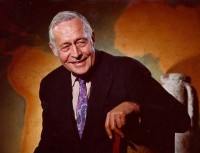
Next Revelle hired a Geochemist named David Keeling to devise a way to measure the atmospheric content of Carbon dioxide. In 1960 Keeling published his first paper showing the increase in carbon dioxide in the atmosphere and linking the increase to the burning of fossil fuels. These two research papers became the bedrock of the science of global warming, even though they offered no proof that carbon dioxide was in fact a greenhouse gas. In addition they failed to explain how this trace gas, only a tiny fraction of the atmosphere, could have any significant impact on temperatures.
Now let me take you back to the 1950s when this was going on. Our cities were entrapped in a pall of pollution from the crude internal combustion engines that powered cars and trucks back then and from the uncontrolled emissions from power plants and factories. Cars and factories and power plants were filling the air with all sorts of pollutants. There was a valid and serious concern about the health consequences of this pollution and a strong environmental movement was developing to demand action. Government accepted this challenge and new environmental standards were set. Scientists and engineers came to the rescue. New reformulated fuels were developed for cars, as were new high tech, computer controlled engines and catalytic converters. By the mid seventies cars were no longer big time polluters, emitting only some carbon dioxide and water vapor from their tail pipes. Likewise, new fuel processing and smoke stack scrubbers were added to industrial and power plants and their emissions were greatly reduced, as well.
But an environmental movement had been established and its funding and very existence depended on having a continuing crisis issue. So the research papers from Scripps came at just the right moment. And, with them came the birth of an issue; man-made global warming from the carbon dioxide from the burning of fossil fuels. Read much more about what followed including Revelle having strong second thoughts on the CO2 science here.
John concludes: And, I am totally convinced there is no scientific basis for any of it. Global Warming. It is the hoax. It is bad science. It is a high jacking of public policy. It is no joke. It is the greatest scam in history.
Note: A reader noted that the story did not touch on Gore et al’s immoral attack on Singer and the recently deceased Revelle after the publication of the paper shown here.
Jan 28, 2009
Glacier Slowdown in Greenland: How Inconvenient
World Climate Report
In this week’s Science magazine, science writer Richard Kerr reports on some of the goings-on at this past December’s annual meeting of the American Geophysical Union. While he didn’t cover our presentation at the meeting in which we described our efforts at creating a reconstruction of ice melt across Greenland dating back into the late 1700s (we found that the greatest period of ice melt occurred in the decades around the 1930s), Kerr did cover some other recent findings concerning the workings of Greenland’s cryosphere in his article titled “Galloping Glaciers of Greenland Have Reined Themselves In.”
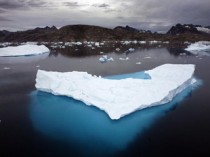
Here is how Kerr starts things off: “Things were looking bad around southeast Greenland a few years ago. There, the streams of ice flowing from the great ice sheet into the sea had begun speeding up in the late 1990s. Then, two of the biggest Greenland outlet glaciers really took off, and losses from the ice to the sea eventually doubled. Some climatologists speculated that global warming might have pushed Greenland past a tipping point into a scary new regime of wildly heightened ice loss and an ever-faster rise in sea level.
And some non-climatologists speculated disaster from rapidly rising seas as well. During his An Inconvenient Truth tour, Gore was fond of spinning the following tale:"[E]arlier this year [2006], yet another team of scientists reported that the previous twelve months saw 32 glacial earthquakes on Greenland between 4.6 and 5.1 on the Richter scale - a disturbing sign that a massive destabilization may now be underway deep within the second largest accumulation of ice on the planet, enough ice to raise sea level 20 feet worldwide if it broke up and slipped into the sea. Each passing day brings yet more evidence that we are now facing a planetary emergency - a climate crisis that demands immediate action to sharply reduce carbon dioxide emissions worldwide in order to turn down the earth’s thermostat and avert catastrophe.”
Oh how things have changed in the past 2 years. Gore’s “massive destabilization” mechanism for which the earthquakes were a supposed bellwether (meltwater lubrication of the flow channel) has been shown to be ineffective at producing long-term changes in glacier flow rate (e.g. (Joughin et al., 2008; van de Wal et al., 2008). And for still another, the recent speed-up of Greenland’s glaciers has even more recently slowed down.
Here is how Kerr describes the situation: “So much for Greenland ice’s Armageddon. “It has come to an end,” glaciologist Tavi Murray of Swansea University in the United Kingdom said during a session at the meeting. “There seems to have been a synchronous switch-off” of the speed-up, she said. Nearly everywhere around southeast Greenland, outlet glacier flows have returned to the levels of 2000.
All told, it is looking more like the IPCC’s estimates of a few inches of sea level rise from Greenland during the 21st century aren’t going to be that far off- despite loud protestations to the contrary from high profile alarm pullers.
Maybe Gore will go back and remove the 12 pages worth of picture and maps from his book showing what high profile places of the world will look like with a 20-foot sea level rise ("The site of the World Trade Center Memorial would be underwater"). But then again, probably not - after all the point is not to be truthful in the sense of reflecting a likely possibility, but to scare you into a particular course of action. Read full report here.
Jan 27, 2009
Observed Climate Change and the Negligible Global Effects of GHG Emissions in Alaska
SPPI
The climate of Alaska has changed considerably over the past 50-plus years. However, human emissions of greenhouse gases are not the primary reason. Instead, the timing of the swings of a periodic, natural cycle - the Pacific Decadal Oscillation (PDO) - has made a strong imprint on the observed climate of Alaska since the mid-20th century. Despite its established existence and influence, this natural cycle is often overlooked or ignored in zealous attempts to paint the current climate of Alaska as being one primarily molded by the emissions from anthropogenic industrial activities. In truth, the climate of Alaska and the ecosystems influenced by it have been subject to the cycles of the PDO and other natural variations since the end of the last ice age (some 12,000 years ago) and likely for eons prior.
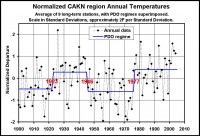
See larger image here from this paper.
It is primarily these natural cycles that are currently shaping Alaska’s long-term climate and weather fluctuations. Local and regional processes are the most important determinants of the climate experienced by local and regional ecosystems, including human populations. Global-scale influences are much harder to detect and their influence on regional scale changes is uncertain. In fact, global climate models which project changes in future climate are unable to reliably model local and regional changes - the most important ones in our daily lives.
Therefore, efforts to control global processes through local changes are largely useless when it comes to the climate. For instance, the greenhouse gases emitted by human activities each year in the state of Alaska amounts to less than 0.2 percent of the global total human greenhouse gas emissions. Industrial growth in China adds an additional Alaska’s worth of carbon dioxide into the atmosphere each and every month (over and above its baseline emissions). This leads to the inescapable conclusion that even a complete cessation of all carbon dioxide emissions originating from Alaska would be subsumed by global greenhouse gas emissions increases in less than three week’s time. What’s more, carbon dioxide emissions reductions in Alaska would produce no detectable or scientifically meaningful impact on local, regional, or global climate. Unfortunately, the same cannot be said for the economic consequences of greenhouse gas emissions’ legislation - they have been recently estimated to be large, and negative, for the citizens of Alaska. Read full analysis here.
See Icecap paper that agrees with this analysis of the controlling role of the PDO in Alaska climate here.
Jan 24, 2009
Profiles in Cowardice
By Paul Chesser in the American Spectator
The intimidation tactics and belittling words of those in global warming alarmism are only a means to cloak the weaknesses of their arguments, especially now that the scientific and economic evidence has found a broader, more receptive audience—check the latest poll results if you don’t believe me.
Put succinctly, their efforts to silence opposing viewpoints to their dogma have only proven that they are a bunch of chicken-twits. Now that doubting Dorothy has doused Elmira Gulch’s other ego with a cocktail of moderating temperatures and an economy in distress, the cries that their forecasts are “melting, melting, aagghhhh” approach a shrill peak.
What has happened in Arkansas the last few weeks is illustrative. The story starts, as is the case in so many states, with Gov. Mike Beebe’s (video link) creation of the Governor’s Commission on Global Warming. In most other states where they’ve been developed, these panels have been fashioned purely by executive fiat. Arkansas’s GCGW was authorized also by a law (PDF) to study potential impacts of global warming and ways to mitigate greenhouse gas emissions (the presumed evil behind global temperature uptick). But the GCGW was also given the mandate to “study the scientific data, literature, and research on global warming to determine whether global warming is an immediate threat to the citizens in the State of Arkansas….”
Turns out this area of “study” was only allowed to go so far. As is the standard when the Center for Climate Strategies is granted management control of a state’s climate commission (approaching two dozen so far), the prerequisite for CCS to take the job is that no debate of the climate science is allowed. Like the intolerant Al Gore, CCS cannot suffer dissent, flat-earthers, or moonwalk-deniers.
As 2008 closed, syndicated columnist David Sanders of roughly two dozen Arkansas newspapers trained his critical eye upon the sham process that was the GCGW. And again. And again. And again. And again. And again. Yes, six (6) times. As Dr. Ford sounded warnings about the GCGW with legislators, Sanders’s reports drew out others on the commission with similar gripes.
“The commission members themselves weren’t as big of participants as was CCS, quite frankly,” said Gary Voigt, president of the Electric Cooperatives of Arkansas. “Commission members didn’t have the input; CCS’s consultants had most of the input. There was a structure and a goal.” “As a commissioner,” said Kevin Inboden of Jonesboro’s city and water utility, “when I hear that the commission recommended this or that, it doesn’t tell the whole story. There was a lot of dissension and opposition.”
The piece de resistance of the resistance came in a legislative hearing held last week in Little Rock, in which famed atmospheric scientist skeptic Roy Spencer, “Red Hot Lies” author Chris Horner, and two myth-busters from the Science and Public Policy Institute delivered multiple puncture wounds to global warming alarmism. As a local left-wing blog threw apoplectic fits, a Democratic Senate committee chairman tried to shut the meeting down. But the pressure brought by Sanders, the scheduled skeptics, and the bold dissenters on GCGW was too much, and the hearing was held.
The Arkansas scenario was a microcosm of the alarmists’ flailing on the issue globally. The more they try to silence their opposition, and portray them as unworthy of contemplation while positing their own outrageous doomsday scenarios, the further they push themselves to the fringe in public perception. That so many who hear these calamity predictions are freezing their keisters this winter doesn’t help the warming cause.
Before long the alarmists who have so desperately and cowardly avoided debates will be begging for them, so they can recover their evaporated credibility. Read full account here.
|








